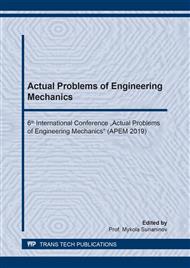p.176
p.185
p.200
p.209
p.227
p.234
p.240
p.248
p.258
Experimental Studies of Reinforced Concrete and Fiber-Reinforced Concrete Beams with Short-Term and Long-Term Loads
Abstract:
Experimental studies of the stress-strain state of reinforced concrete and fiber-reinforced concrete beams under short-term and long-term loads were carried out. The tests were carried out on three series of beams of different types - from ordinary concrete, steel fiber concrete and combined section, when the lower zone of the beam with a height of 0.5h is made of steel fiber concrete, and the upper one is made of ordinary concrete. During short-term loading, the load was applied in steps with a 10-minute exposure at each step to failure or to a predetermined level of a continuously acting load. In the interval between the steps, the process of cracking was tracked. After reaching a given level of loading, the load was fixed and maintained unchanged with a spring cassette for 300 days. Deformations were measured using strain gauges and dial gauges. Deflections and relative deformations of the extreme upper and extreme lower fibers for three types of beams are determined. It has been established that stabilization of deflections in beams from steel fiber concrete occurs much earlier (100 days) than in beams made of ordinary concrete (175 days). Studies have shown that the beams of ordinary concrete in the process of long-acting load lowered the carrying capacity by 5.5%. The bearing capacity of steel concrete beams, in contrast, increased by 7.6%.
Info:
Periodical:
Pages:
227-233
Citation:
Online since:
August 2019
Authors:
Keywords:
Price:
Сopyright:
© 2019 Trans Tech Publications Ltd. All Rights Reserved
Share:
Citation:


